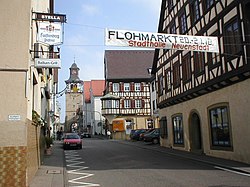Neuenstadt am Kocher
| Neuenstadt am Kocher | ||
|---|---|---|

Main street
|
||
|
||
| Coordinates: 49°14′N 9°20′E / 49.233°N 9.333°ECoordinates: 49°14′N 9°20′E / 49.233°N 9.333°E | ||
| Country | Germany | |
| State | Baden-Württemberg | |
| Admin. region | Stuttgart | |
| District | Heilbronn | |
| Government | ||
| • Mayor | Norbert Heuser | |
| Area | ||
| • Total | 41.18 km2 (15.90 sq mi) | |
| Elevation | 182 m (597 ft) | |
| Population (2015-12-31) | ||
| • Total | 9,630 | |
| • Density | 230/km2 (610/sq mi) | |
| Time zone | CET/CEST (UTC+1/+2) | |
| Postal codes | 74196 | |
| Vehicle registration | HN | |
| Website | www.neuenstadt.de | |
Neuenstadt, usually known as ![]() Neuenstadt am Kocher (and until as late as 1800 also known as Neuenstadt an der großen Linde) is a town in Baden-Württemberg in south-western Germany with 9,600 inhabitants. It consists of Neuenstadt, the villages of Stein am Kocher, Kochertürn, Cleversulzbach and Bürg and the hamlets Brambacher Hof (part of Kochertürn), Buchhof and Lobenbacher Hof (part of Stein). The name Neuenstadt is derived from the “neue Stadt” or “New Town” in English.
Neuenstadt am Kocher (and until as late as 1800 also known as Neuenstadt an der großen Linde) is a town in Baden-Württemberg in south-western Germany with 9,600 inhabitants. It consists of Neuenstadt, the villages of Stein am Kocher, Kochertürn, Cleversulzbach and Bürg and the hamlets Brambacher Hof (part of Kochertürn), Buchhof and Lobenbacher Hof (part of Stein). The name Neuenstadt is derived from the “neue Stadt” or “New Town” in English.
Neuenstadt lies on the Kocher river in the east of the District of Heilbronn. It stands on a hill where the Brettach flows into the Kocher river.
Starting from the south going in a clockwise direction, Neuenstadt is surrounded by Eberstadt, Neckarsulm, Oedheim, Bad Friedrichshall, Neudenau, Hardthausen am Kocher and Langenbrettach (all also in the district of Heilbronn). Neuenstadt is part of a joint administration agreement with Hardthausen am Kocher and Langenbrettach.
The town of Neuenstadt is subdivided into the districts of Neuenstadt itself, Stein am Kocher, Kochertürn, Cleversulzbach, Bürg and the hamlets of Brambacherhof, Buchhof and Lobenbacher Hof (of Stein).
Neuenstadt was originally a settlement known as Helmbund which was first mentioned in records as early in 797 A.D. Helmbund stood in the meadows of Brettach. It is believed that the settlement moved a kilometer away at some time around the beginning of the 14th century to avoid flooding. Since then it has stood on higher ground between the Kocher and Brettach rivers. This gave rise to name New Town, or "Neue Stadt" in German. The hamlet of Helmbund subsequently all but disappeared with only the scattered ruins of the Gothic church of Helmbund remaining. Neuenstadt first fell under the reign of the rulers of Weinsberg whose lineage came to an end in 1507. As a result, it was originally a town from the Electorate of the Palatinate before falling into the area of Württemberg in 1504. In the 17th and 18th century the Württemberg-Neuenstadt branch line of the ducal house of Württemberg took up residence in Neuenstadt castle until the male lineage of dukes died out in 1742.
...
Wikipedia



